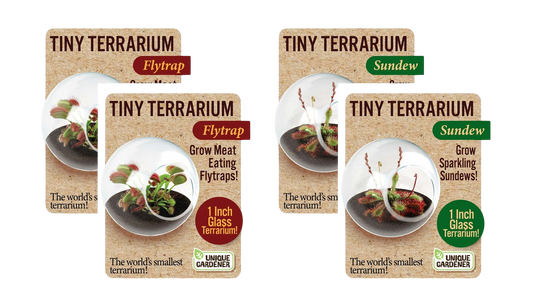Automatic Free Shipping on Orders $50.00 and more!
Collection: Carnivorous Plants Collection
Grow some of the most fierce Meat-Eating Plants in the World from Seed!
At Toys By Nature, we offer a variety of kits to grow these fascinating plants from seed. While they are fun and rewarding to grow, it s critical that the planter reads and follows all the instructions for germinating and caring for these special meat-eating plants. For example, only distilled or collected rainwater can be used to water them. They also take 6 weeks to 3 months to sprout. We think it is worth it all. Unlike many plants that have different foliage in their juvenile stages and look different from their adult form, these amazing plants look like tiny miniatures of their adult forms very early on after sprouting. They are slow growers and can flourish for years in the included container with the proper care.
Fly Traps
The famous Venus Fly Trap, a native of coastal North and South Carolina, forms a hinged trap that typically has three little triggers on the inside of each half. When an insect touches one of the triggers, the plant gets ready to spring into action. When the same or another one is touched, the trap quickly slams shut. Digestive enzymes secreted by glands within the trap decompose the insect’s body. The trap will open again in a week or two to capture another meal.
Sundews
Sundews produce leaves with tentacles that produce a very sticky glue-like substance. They glisten in sunlight and are called “The Jewels of the Plant World.” Insects are attracted to the tentacles and quickly become stuck. Adjoining tentacles bend and attach to the body of the unlucky bug. Digestive enzymes eventually absorb the nutrients from the insect, thus nourishing the plant.
Pitcher Plants
Pitcher plants form tube traps that produce a sweet smell and sap on the slippery rim of the trap to attract insects. Insects are enticed to stroll around the rim and if they are not careful, will fall into the narrow tube or vessel. The inside surface of the tube is very waxy, and the victim is usually unable to crawl back up to freedom. The top closes and the pitcher fills up with digestive juices to eat the insect.
Did You Know?
-There are over 650 species of meat-eating plants that are native to all Continents except Antarctica.
-North America was once home to vast numbers of carnivorous plants in what are sometimes called “wetland habitats.”
-American species are some of the most spectacular in form and color of all meat-eating plants!
-Carnivorous Plants live in humid and poor nutrient habitats and have developed their carnivorous habit to supplement their diet with mineral loaded insects.
-All Carnivorous Plants have highly modified leaves that form traps that lure and then capture prey.
-
Carnivorous Creatures Biosphere Terrarium
Vendor:Toys By NatureRegular price $29.99 USDRegular priceUnit price / per -
Eco Seed Sprouts Flytrap Ed - Multipack of 5
Vendor:Toys By NatureRegular price $24.99 USDRegular priceUnit price / per -
Fred 'The Ferocious' Flytrap Micro Dome Terrarium
Vendor:Toys By NatureRegular price $16.99 USDRegular priceUnit price / per -
Frightening Flytraps Mini World Terrarium
Vendor:Toys By NatureRegular price $19.99 USDRegular priceUnit price / per -
Venus Fly Trap Seed Square Terrarium
Vendor:Unique GardenerRegular price $19.99 USDRegular priceUnit price / per -
Carnivorous Tiny Terrariums Bundle - 2 each of 2 Varieties
Vendor:Unique GardenerRegular price $19.99 USDRegular priceUnit price / per -
The Meat Eating Mouse Garden Glass Terrarium with Cork
Vendor:Unique GardenerRegular price $19.99 USDRegular priceUnit price / per -
Flytrap Garden Glass Terrarium Seed Starting Kit
Vendor:Unique GardenerRegular price $19.99 USDRegular priceUnit price / per -
Carnivorous Growarium Meat-Eating Seed Terrarium Kit
Vendor:Unique GardenerRegular price $29.99 USDRegular priceUnit price / per


















